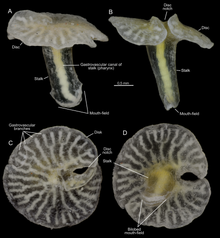Dendrogramma
| Dendrogramma | |
|---|---|
 |
|
| Dendrogramma enigmatica | |
| Scientific classification | |
| Kingdom: | Animalia |
| Phylum: | Cnidaria |
| Class: | Hydrozoa |
| Order: | Siphonophorae |
| Family: | Rhodaliidae |
| Genus: |
Dendrogramma Just, Kristensen, & Olesen, 2014 |
| Type species | |
|
Dendrogramma enigmatica Just, Kristensen, & Olesen, 2014 |
|
| Species | |
|
|
Dendrogramma enigmatica is a species of siphonophore, the only species of its genus, identified in 2014 from a collection of specimens gathered in 1986 and identified as a siphonophore from RNA material from new specimens in 2016. The specimens are presumed to represent parts (bracts) of the entire siphonophore, which has not been identified yet.
The Dendrogramma specimens were collected off the south-east coast of Australia during a scientific expedition in 1986. They were collected at water depths of 400 metres (1,300 ft) and 1,000 metres (3,300 ft) on the continental slope near Tasmania, using a sled that was dragged over the sea floor to collect bottom-dwelling animals. The researchers were immediately struck by the unusual characteristics of the 18 specimens they collected. These were preserved in formaldehyde, and later in ethanol, for further study.
On returning to the sample site in 1988, the researchers were unable to find any further specimens. It was not until 2014 that they published the discovery. Jean Just of the University of Copenhagen, who carried out the trawling in 1986, has explained the long delay before publication in terms of the extraordinary nature of the discovery: "Once you think you have something really extraordinary, it takes a long time to study, read, consult left, right and centre, and convince yourself that you’ve really stumbled across something special."
When initially discovered, Dendrogramma's relationships were unclear. The two purported species were assigned their own genus, Dendrogramma, and family, Dendrogrammatidae; and the researchers even considered putting them in their own phylum. As they put it, however, "we refrain from erecting such a high-level taxon for the time being, because new material is needed to resolve many pertinent outstanding questions." The lead scientist of the identification effort, Jørgen Olesen of the University of Copenhagen, suggested that they represent "an early branch on the tree of life, with similarities to the 600 million-year-old extinct Ediacara fauna." At least three genera of Ediacarans—Albumares, Anfesta, and Rugoconites—share similarities with Dendrogramma; all three appear to have possessed a disc with an internal network of forking channels. This possibility generated considerable excitement: Simon Conway Morris of the University of Cambridge stated that the discovery is "a very interesting surprise, and it poses lots and lots of questions." He noted the "most intriguing similarity to certain Ediacaran forms," but cautioned that "the similarities are exactly that. They are intriguing rather than compelling." Genetic identification was not possible with the original specimens, as they were preserved with formaldehyde and alcohol, a method that does not preserve nucleic acids.
...
Wikipedia
